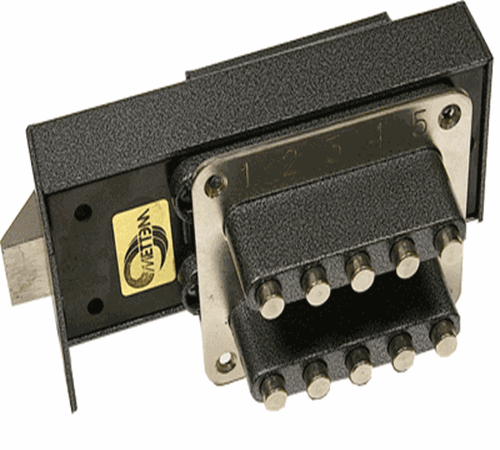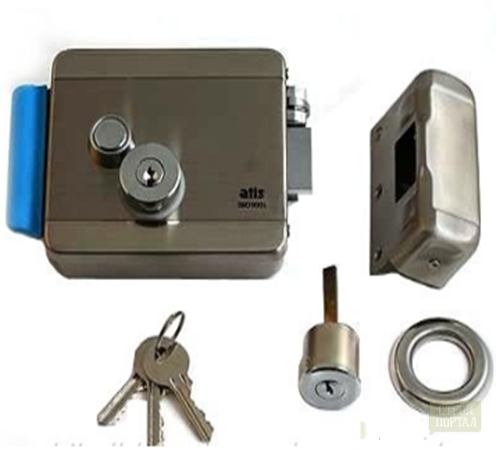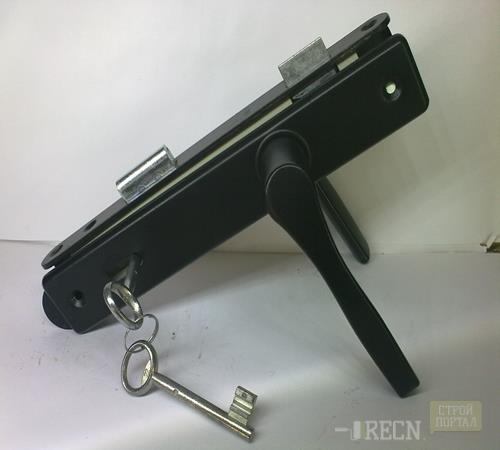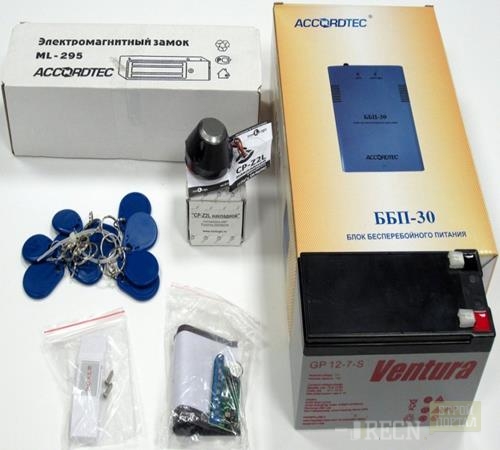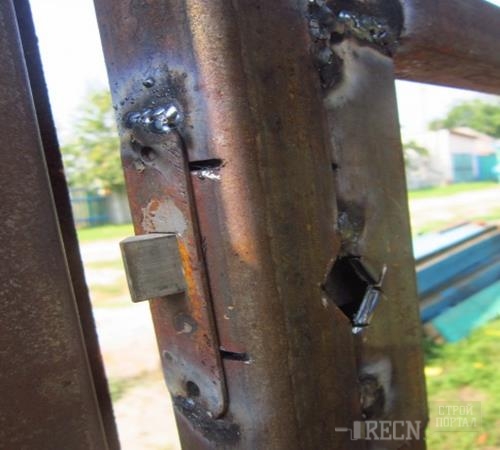
How to install a lock on the gate with your own hands Plot
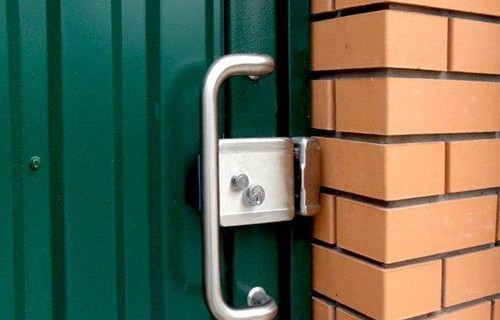
How to install a lock on the gate with your own hands
The lock on the gate is an important part of any entrance door, especially street. There are quite a lot of varieties of locks and the methods of their attachment, in addition, certain nuances occur in connection with the material, the door canvase. About all the intricacies of the castle mounting procedure and will be discussed.
Content
Material from which the wicket is made
As a rule, the input wickets make from:
- metal sheet,
- frame with mesh,
- bayonets
- tree.
Each of the designs involves a specific installation procedure and a strictly limited set of types of locks. Each case will then consider in more detail. But, if the wicket is not yet installed, I will add a few words about the advantages of each material.
The most reliable steel sheet. The wicket is performed in three variations:
- one-sided
- one-sided with a corner
- bilateral.
In practice, it is more convenient and practical one-sided wicket with a corner. It allows you to mount any types of locks (even mortise), while it is fairly inexpensive.
Metal frame with a grid is suitable for the gate at the cottage. It does not provide a real defense, it is also difficult to mount the castle.
The wicket welded from the reinforcement is quite reliable. If you install top of the bayonets, then it will be closed through it. The disadvantage is that you will need to weld a special place for the castle. From aesthetic point of view, it looks unsightly.
Wooden wickets are used in villages. If you wish, they are equipped with a mortise lock, but in the open air he will quickly deteriorate and come into disrepair. Standard jacks do not provide practically no protection.
Varieties of castles
Before starting to install, it is still necessary to choose a castle, suitable for both the price and quality. To date, there are the following types:
- whether
- hinged
- overhead,
- mortise
- electromagnetic,
- electromechanical,
- radio wave
- sound.
Racial mechanisms are a design that consists of the loops of the fixators and the dock moving along them. In theory, this is a fairly reliable castle, but in practice it is difficult to achieve high defense. First, the thickness of the loops and the base should be at least 4 mm, and secondly, the loops must be welded to the base of the wicket and the fence, thirdly, the gap between the wicket and the end of the fence allows you to push the blade for the cutter for the metal and repel the Caps. Currently practically do not apply. Another minus, you can only close the gate from the inside.
Attachments (barn) castles are even less reliable than roll. But they allow you to use the gate from both sides. Due to the fact that they are cheaper than everything, are often used in cottages or sites on which the visits of uninvited guests will not bring any losses.
The invoice lock on the gate can already be called full, it is difficult to hack without special skills and tools. In addition, the installation is carried out very quickly and in most cases only requires the presence of a drill or welding machine. The obvious disadvantage - the invoice lock adjacent to the canvas of the wicket, and in the presence of scrap or the fombus it is easy enough to get out.
Cutting locks are installed inside the canvas. This allows you to maximize the door from the physical hacking methods. However, even a conventional brand made of hairpins, the lock opens in seconds. In addition, for most street wickets, this type of castle is very problematic.
The electromagnetic lock on the wicket is well familiar to residents of multi-storey houses. It is a system of a gate mechanism and a magnet key. The mechanism is configured to the electromagnetic key of the key. If you bring the key to the mechanism, it opens. These castles appeared about 10-15 years ago and at that time were 100% reliable. Today, it is not difficult to choose an electromagnetic combination with special equipment. By and large, all the necessary set is in any school class physics.
Much more reliable than an electromechanical lock on a gate or, as it is also called, code. The mechanism consists of a shutter mechanism and a visual interface. In order to open or block the lock, you need to enter the code. The great advantage of this type of mechanisms is that it is possible to change the password. At the same time, there is a large drawback - electricity. Naturally, most modern options possess either their own battery or batteries, but the charge will end at the most inopportune moment. Replace the battery item only from the inside. It is worth adding that some manufacturers equip their products with photocells, which during the day conduct permanent recharging batteries. It will be possible to choose the code only with the presence of expensive high-precision equipment (or special powders, to remove fingerprints).
One of the subspecies of the electromechanical castle - involves the use of a classic shut-off mechanism on the keys. In this case, instead of a combination of numbers, an electrical signal is used, which is supplied by a special button.
Radio Castle on the principle of action is similar to the car alarm. Today it is the most reliable, since the selection of the desired wave will require very expensive equipment and deep knowledge in radio engineering. On the other hand, the installation will take a lot of time, in addition, the mechanism will have to be ordered from a private firm (not serially produced).
The new generation of castles offered mechanics from Japan. Their principle of action resembles ABC Morse. The locking mechanism is equipped with artificial intelligence, which is able to accept and analyze sounds. The lock code is set by a set of different strength knocks. It was not yet available on sale, but it is already expected soon.
Another interesting option is a combination of an electromagnetic and radio wave lock. A combination is used, for example, in the latest models of Mersedes, BMV and PORSHE. The principle of operation is that the console sends a command to the locking mechanism to remove protection from the magnetization point (the place to which the normal magnetic key is applied), then you need to attach the magnetic key to the lock (or is at a certain distance from the lock). The automotive system is focused on protecting the ignition lock, but it is easy to adapt and under the input wicket. The only minus is a very high cost and a small number of masters who will take for this work.
Additional means of protecting the castle
Various electronic modifications of locks are quite expensive. Overhead and mortise analogues are not very reliable, nevertheless easier and cheaper to buy a lock for wicket and equip it with additional protection tools.
In the previous sections, we reviewed only the main types of locks, each of them also has various modifications of shut-off mechanisms. Just they allow you to make a truly reliable protection from a regular overhead lock. The following parts are subject to replacement and modifications:
- axial sleeve
- lock sleeves
- protective plates,
- suwald plates.
The axial sleeve is the castle itself. As a rule, it has a center point. She records the positions "open" and "closed". If the point of the center is drilled, the castle "goes crazy" and stops working, the door can be broken by a conventional knife.
There are axial bushings with a shifted center, it is difficult to find it and in 90% of cases eliminates the possibility of penetration.
Lock sleeves or the shutter itself be made of alloy steel, high-strength steel and titanium. The last option is made mainly to order, but it does not succumb to dying, not subject to corrosion and serves almost forever.
Protective and suvalid plates are completely unresolved concepts. The first is an additional element from titanium or alloyed high-strength steel, which closes the inlet, completely exclude mechanical hacking and the ability to drill the lock.
Suwald plates are a set of small, set in a certain sequence, metal plates that interact with the keyboard key. The pattern should be exactly the coincidence with a notch on the key, otherwise the lock will not open (this type of protection refers to locks with laser notch).
A sufficiently specific method of protection is a constant current. Immediately note that it is dangerous for life. The procedure is quite simple, squeeze the lock from the network. At the same time, the space around it should be fully overlaced. If someone tries to shove something metallic in the lock or start drilling it, the robber will hit the current. In accordance with the legislation (and in order to avoid responsibility), the warning plate with the inscription "Caution High Voltage" should be on the gate. In connection with certain risks, it is recommended to use this method only to owners of private houses.
How to install a lock on the gate
Mounting technology depends on the type and material of the door. Most often, the wicket is made of steel sheet to which the corner is welded around the edges. On such a construction, usually put the castle.
The procedure includes the following items:
- place marking - you need to accurately mark the position of the lock on the gate and the inlet holes for the lock on the box.
- preparation for fastening - you need to drill holes for screws and a shut-off mechanism,
- fastening - fasten the lock to the gate,
- assembly - set the handles.
More expensive overhead locks have a retaliatory bar if the box is made of metal, the bar is simply welded, it is more reliable than fixing it with screws.
Code locks (electromechanical) for its design resemble the overhead. In addition to the main mechanism and response, the design consists of an input interface. It happens:
- mechanical,
- electronic.
Mechanical is represented by either a panel with buttons, or a similar panel with a visual interface. Both variants are mounted equally, the difference is that in the mechanical interface it is necessary to simultaneously press the combination of numbers, and in the electronic to type the code is sequentially (respectively, the length of the code is limited only by imagination).
To install the interface in the gate, you must cut the opening of the appropriate size. It is attached to the lock mechanism with several inner screws. If you break it, the door will not open.
Electromagnetic and radio wave locks are both overhead and mortis. It is easier to naturally install an overhead option. If you decide to embed the lock to the gate, then this procedure will be obtained only if the web consists of two independent parts. This circumstance is due to the fact that the setting of these locks implies free access to the mechanisms.
The installation procedure itself does not differ from the installation of the overhead lock, the exception that after the cutting it is necessary to install and secure the second part of the wicket canvase.
Cutting locks are installed either in wooden doors or in consisting of two independent canvases. How to fix the lock on the metal gate is described above, so consider the installation of the mechanism on the wooden door.
For this you need:
- place the end and side sides of the wicket,
- drill through the end hole for the lock mechanism,
- drill with a side hole for fastening the handles,
- consolidate the response bar (or make a hole instead),
- insert a castle
- attach locking overlays and pull them with bolts,
- set knobs.
If additional protective elements are used in the lock design, their installation occurs in advance. To do this, you must fully disassemble the lock mechanism and replace or add the appropriate parts.
Tip: If you do not really understand the lock device, write down each step in a notebook, this will allow you to assemble the lock back without any problems (extra bolts will not remain). For clarity, it is advisable to draw a mechanism and sign its details, both in the assembled and disassembled.





